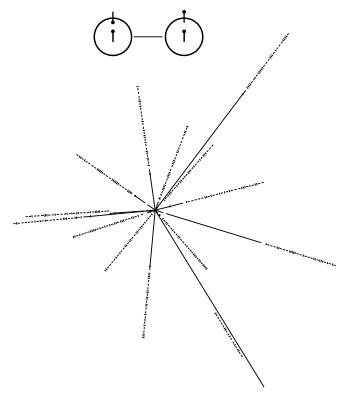Pulsar GPS
September 11, 2013
One question that
philosophers and
scientists have asked themselves throughout the ages is how you could communicate information to a
remote, non-human culture. One problem before the middle of the
twentieth century was communicating the difference between right and left, or up and down. That problem was settled by an
experiment which showed that
parity was violated in
beta decay.
Since it's presumed that the
laws of physics are the same no matter where you are in the
universe, it makes sense to define quantities with reference to
fundamental physical constants. If you could somehow communicate the concepts of
helium,
neon, and
lasing, then you could communicate the dimensions of objects with reference to the 632.8
nm wavelength of the
He-Ne laser. You need to be careful in your wording, however, since a He-Ne laser will also emit at other wavelengths, notably 1150 nm.
When it was realized that the
Pioneer 10 and
Pioneer 11 spacecraft would eventually escape our
Solar System, it was decided that there should be information placed on them as to their origin in the unlikely event that they would find their way into
extraterrestrial, or perhaps future human,
hands (or
tentacles). This was more of a
symbolic gesture to contemporary humans than anything else.
This task was undertaken by American
astronomer Carl Sagan, principally because he was one of the few scientists at the time with an avowed interest in
communicating with extraterrestrials. In 1966, Sagan had coauthored the book, "Intelligent Life in the Universe," with
Soviet astronomer,
I. S. Shklovskii, a copy of which sits in my library.[1]

Carl Sagan at the founding of The Planetary Society, 1980.
(Planetary Society/NASA/JPL photograph, via Wikimedia Commons.)
Sagan and colleague,
Frank Drake, who was the first to listen in 1960 for extraterrestrial radio signals from nearby stars in
Project Ozma, designed a
plaque to convey essential information on
Earth's location in our
Milky Way Galaxy, the composition of the Solar System (with
Pluto as a planet), and the appearance of male and female humans. The artwork was rendered by Sagan's wife,
Linda, an artist.
The Pioneer plaque was conceived as not just a pretty picture, but as a means to convey some quantitative data. Sagan and Drake faced the problem of how to transfer position information to a scientifically knowledgeable, but alien culture. As
radio astronomers, their choice of a length scale was obvious. The visible universe is mostly
hydrogen, and hydrogen undergoes a fundamental, but extremely rare transition, from the
spins of its
electron and
proton being
parallel to anti-parallel.
This transition may be rare, but there's so much hydrogen around that there's an easily detected
radio emission, called the
hydrogen line, at 1420.406
MHz. This has a corresponding wavelength of 21.1061
cm, which is a good
ruler for
macroscopic objects such as humans. The emission frequency can be used as a
time reference with a
period of 0.704024061
nanoseconds.
As a map locating the Earth, Sagan and Drake used a radial pattern showing the relative distances of fourteen
pulsars from the
Sun (see figure). The pulsars are identified by their periods, in
binary code, in units of the hydrogen period. There's a diagram of the hydrogen transition that specifies it as a unit time and a unit length.

Pulsar graphics portion of the Pioneer 10/11 plaque, as designed by Carl Sagan and Frank Drake.
The hydrogen transition reference is depicted, also.
(A vector graphics reproduction of the Pioneer plaque by Oona Räisänen;, via Wikimedia Commons.)
The pulse period of pulsars is at least as stable as an
atomic clock, but pulsars do run-down. The pulse period of pulsars is the same as their
rotation rate, and they slow down as they lose
energy. The period of normal pulsars increases by about 10
-15 parts every rotation. The period of
millisecond pulsars increases by about 10
-20 parts every rotation. The period of the pulsars on the Pioneer plaque will change in time, but this is an advantage, since it will indicate the age of the spacecraft.
The idea of using pulsars for
space navigation was first proposed in 1974.[2] A 2011 paper in the journal,
Advances in Space Research, by
physicists at the
Politecnico di Torino (Polytechnic University of Turin) and the
Istituto Nazionale di Fisica Nucleare (National Institute for Nuclear Physics), both located in
Turin, Italy, studied this idea in greater detail.[3] This research has been followed-up by
Australian scientists at the
Commonwealth Scientific and Industrial Research Organisation (CSIRO) in a paper scheduled to appear in the same journal.[2,4]
The Australian research team demonstrated that pulsars can be useful for
interplanetary navigation as well.[2,4] Spacecraft are presently tracked from the Earth, but
precision decreases with distance from the Earth.[2] If as few as four millisecond pulsars can be observed for about an hour every seven days, spacecraft position could be ascertained to within 20
kilometers, and
velocity to within a tenth of a
meter per second.[2,4] One
enabling technology for this is the
development of
compact Xray detectors that can observe the
Xray component of some pulsars.[2]
Another interesting result of the study is a determination that the Earth goes around the Sun, and not vice-versa. Says team leader,
George Hobbs, "This was nailed a couple of hundred years ago... but if you still need proof, we've got it."[2]
References:
- I. S. Shklovskii and Carl Sagan, "Intelligent Life in the Universe," Dell Publishing paperback, January 1, 1968 (via Amazon).
- Pulsars make a GPS for the cosmos, CSIRO Press Release, August 16, 2013.
- Angelo Tartaglia, Matteo Luca Ruggiero and Emiliano Capolongo, "A null frame for spacetime positioning by means of pulsating sources," Advances in Space Research, vol. 47, no. 4 (February 15, 2011), pp. 645-653. Available, also, from arXiv.
- X. P. Deng, G. Hobbs, X. P. You, M. T. Li, M. J. Keith, R. M. Shannon, W. Coles, R. N. Manchester, J. H. Zheng, X. Z. Yu, D. Gao, X. Wu and D. Chen, "Interplanetary spacecraft navigation using pulsars," arXiv Preprint Server, July 20, 2013.
Permanent Link to this article
Linked Keywords: Philosopher; scientist; extraterrestrial life; non-human; culture; twentieth century; experiment; parity; beta decay; physical law; laws of physics; universe; physical constant; fundamental physical constant; helium; neon; laser; lasing; nanometer; nm; wavelength; He-Ne laser; Pioneer 10; Pioneer 11; spacecraft; Solar System; extraterrestrial; hand; extraterrestrials in fiction; tentacle; symbolic gesture; astronomer; Carl Sagan; search for extraterrestrial intelligence; SETI; communicating with extraterrestrials; Soviet Union; Soviet; I. S. Shklovskii; The Planetary Society; NASA; Jet Propulsion Laboratory; JPL; Wikimedia Commons; Frank Drake; Project Ozma; Pioneer plaque; Earth; Milky Way Galaxy; Pluto as a planet; Linda Salzman Sagan; radio astronomy; radio astronomer; hydrogen; spin; electron; proton; parallel; electromagnetic spectrum; radio emission; hydrogen line; hertz; MHz; centimeter; cm; ruler; macroscopic scale; time; period; nanosecond; pulsar; Sun; binary number; binary code; atomic clock; rotation rate; energy; millisecond pulsar; outer space; navigation; >Advances in Space Research; physicist; Polytechnic University of Turin; Politecnico di Torino; Istituto Nazionale di Fisica Nucleare; Turin, Italy; Australia; Commonwealth Scientific and Industrial Research Organisation; CSIRO; interplanetary; accuracy and precision; kilometer; velocity; meter per second; enabling technology; research and development; silicon drift detector; compact Xray detector; Xray; George Hobbs; I. S. Shklovskii and Carl Sagan, "Intelligent Life in the Universe," Dell Publishing paperback, January 1, 1968.